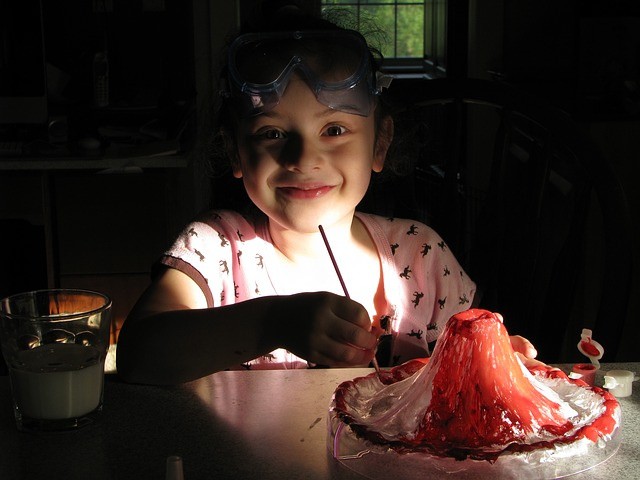Simple Ways to Expose Your Small Child to Science

When you think about introducing science to young kids, you may picture complicated, messy experiments with glass tubes and chemicals. And, since science is such a broad subject, it can be challenging to know just where to start. Before you start gathering up baking soda and bunsen burners, let's look at ways to notice and point out the science built into your everyday routine.
Science is all around us-literally! A great introduction to science is to venture outside and study the weather. Even very young kids can notice and identify whether a day is sunny or cloudy. Get into the habit of looking out the window every day to search for clouds or check for rain or snow. Make a chart and use it to track how many days you have sunshine, cloudy, rainy, etc. Point out patterns in the weather and discuss how seasons change where you live. This activity requires very little time and no equipment-except perhaps rain boots to splash in puddles.
An easy way and safe to introduce your child to the topic of chemical reactions is to let them help you bake. Talk about how leavening agents like baking soda, yeast, and baking powder make bread, cake, and cookies fluffy and light. You could even try to bake something without the leavening to drive home the concept. If you aren't into baking, you can simply combine baking soda and a little vinegar in a container to watch the chemical reaction-no volcano needed!
Take time to notice simple chemical reactions all around you. Point out rust and talk about how water causes a reaction in the metal that leads to rust. If you are a cat owner, switch to a silica cat litter to provide everyday exposure to science. A silica cat litter will change colors when reacting to urine. It can be a quick, easy way to point out chemical changes to young kids.
Another simple way to explore science is to introduce your kids to magnets. Take a magnet off the fridge and have them try to find metal objects around your home to stick it to. After some practice, have them guess whether the magnet will stick to something or not. Give them small metal objects, such as paperclips, that they can experiment with. They will be fascinated with the magnet's attractive properties and will have a lot of fun, too. Just be sure to carefully supervise children whenever they are handling magnets, as they can be dangerous when swallowed.
Another excellent science game to play with kids is "sink or float." Fill up a sink with water and collect items from around your home. Find a variety of objects in a variety of sizes, shapes, and weight. Then, have your child guess whether an object will sink or float in the water before dropping each one into the water. Your child will probably want to test everything in the house once you get started! If you are feeling ambitious, you can try taping a heavy item to a lighter one and then having your child predict whether it will sink or float. It's a great way to get their minds working in a new way and to have a lot of fun in the process. You can even use things like soap or sugar with your sink of water to explain how things dissolve and change states of matter with a reaction as simple as adding water.
With a little thought, introducing young children to science can be a fun, easy part of everyday life!
Subscribe to Latin Post!
Sign up for our free newsletter for the Latest coverage!
© 2025 Latin Post. All rights reserved. Do not reproduce without permission.















